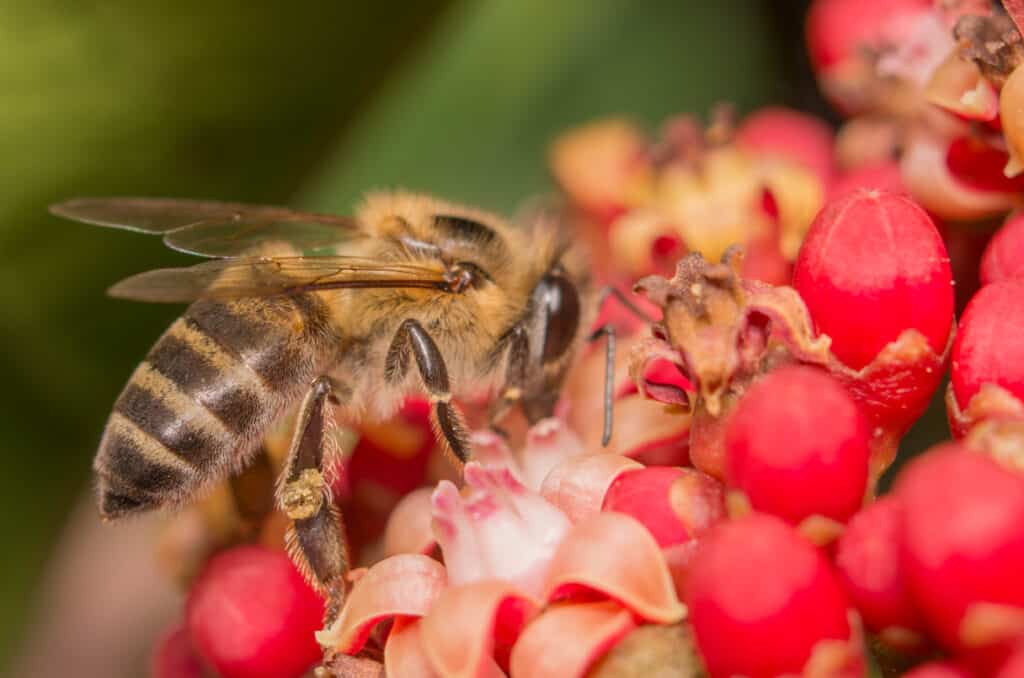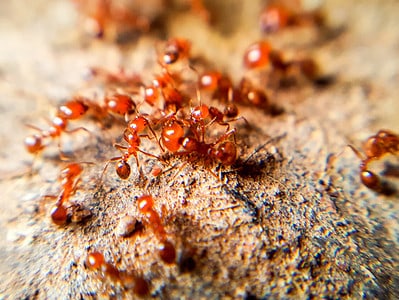Africanized bee (killer bee)
Apis mellifera
Will chase intruders up to a quarter mile from their hives
Advertisement
Africanized bee (killer bee) Scientific Classification
- Kingdom
- Animalia
- Phylum
- Arthropoda
- Class
- Insecta
- Order
- Hymenoptera
- Family
- Apidae
- Genus
- Apis
- Scientific Name
- Apis mellifera
Read our Complete Guide to Classification of Animals.
Africanized bee (killer bee) Conservation Status
Africanized bee (killer bee) Facts
- Name Of Young
- Larvae
- Group Behavior
- Colony
- Swarm
- Fun Fact
- Will chase intruders up to a quarter mile from their hives
- Estimated Population Size
- 40,000 per hive
- Biggest Threat
- Predators
- Most Distinctive Feature
- Highly aggressive swarming tendencies
- Distinctive Feature
- Will abscond and relocate their hives elsewhere when stressed
- Other Name(s)
- Killer bee, Africanized honeybee
- Temperament
- Aggressive
- Wingspan
- 1 inch
- Average Spawn Size
- 1,500-2,000 eggs per day
- Habitat
- Warm environments
- Predators
- Birds, spiders, skunks, badgers, bears
- Diet
- Herbivore
- Lifestyle
- Diurnal
- Colony
- Favorite Food
- Nectar and pollen
- Common Name
- Africanized bee
- Origin
- Brazil
- Number Of Species
- 1
- Location
- North and South America
- Nesting Location
- In wax hives or underground burrows
- Migratory
- 1
View all of the Africanized bee (killer bee) images!
Summary
One of the most aggressive insects in the world, the Africanized bee is a hybrid of the western honey bee. Breeders created the first of these by crossbreeding East African lowland honey bees with European honey bee subspecies. Over the years, numerous hives escaped captivity and spread throughout North and South America. They are much more aggressive than other western honey bee subspecies and are likely responsible for the deaths of thousands of people.
5 Africanized Bee Facts
- Africanized bees tend to swarm more often than other subspecies of honey bee.
- When threatened, they may chase people or animals up to a quarter of a mile from their hive.
- Compared to other honey bees, Africanized bees live in much higher population densities and with greater numbers of guard bees.
- They willingly relocate their hives in response to stress or a lack of abundant food sources.
- To feed their many larvae, Africanized bees harvest greater quantities of pollen and nectar than other honey bees, making them more prolific honey producers.
Africanized Bee Species, Types, and Scientific Name
Also known as Africanized honey bees or killer bees, they are a subspecies of the western honey bee or European honey bee (Apis mellifera). Breeders created Africanized bees by crossbreeding East African lowland honey bees (A. m. scutellata) with several subspecies of European honey bees. Some of the subspecies used to create Africanized bees include the Italian honey bee (A. m. ligustica) and the Iberian honey bee (A. m. iberiensis). The genus name Apis derives from the Latin word for “bee,” while mellifera translates to “honey-bearing” or “honey-carrying.”
Appearance: How to Identify Africanized Bees

To feed their many larvae, Africanized bees harvest greater quantities of pollen and nectar than other honey bees, making them more prolific honey producers.
©Philip Marsden/Shutterstock.com
In terms of appearance, Africanized bees don’t look that different from regular honey bees. They measure between .04 and 1 inch long, with the size varying depending on the bee’s role within a colony. On average, the female worker bees measure slightly smaller than the male drone bees, which in turn measure smaller than the female queen bee. They feature a pair of large, compound eyes, three simple eyes, and a pair of sensitive antennae. Only the females have a stinger. Like other honey bees, they are covered in tiny hairs that appear predominantly brown except for a series of alternating brown and yellow stripes on the abdomen.
Habitat: Where to Find Africanized Bees
As a human-engineered hybrid, they did not occur naturally in the wild until recently. The biologist Warwick E. Kerr introduced Africanized bees to the Western Hemisphere when he brought Eastern African lowland honey bees to Brazil in the 1950s. He bred these bees with the European honey bees common in the Americas at the time in an attempt to create bees better adapted to producing honey in tropical environments. Then, in 1957, 26 swarms escaped activity. These swarms slowly spread throughout the region, interbreeding with wild honey bee colonies.
Since then, Africanized honey bees have spread throughout much of South America and Latin America. The first Africanized bees arrived in the United States sometime in the early 1990s. You can now find them throughout the American south and southwest. They don’t have a specific habitat and can thrive in various environments. Although they require access to water, they can also thrive in drier, desert regions that lack an abundance of food. They are bred for warm temperatures and don’t fare well in particularly cold habitats. This may explain why they have not managed to penetrate further north into the United States or Canada. Most of them construct wax hives in trees, shrubs, or on buildings. However, some also construct underground burrows.
Diet: What Do Africanized Bees Eat?
Like all honey bees, Africanized bees feed on pollen and nectar. They harvest nectar using their mouthparts, also known as a proboscis, and pollen sticks to their bodies during the act of feeding. Africanized honey bees harvest from plants like alfalfa, fruit trees, berries, sunflowers, melons, lavender, dandelion, clover, wild plum willow, locust, and numerous flower species. They use the nectar they collect to develop honey, which they feed on during the colder winter months. In addition, they mix pollen with their honey to create a mixture that they feed to their larvae.
Africanized bees begin foraging at a much younger age compared to other European honey bee subspecies. They also harvest larger amounts of pollen compared to their European kin. The reason for their enhanced foraging capacity stems from their sensitivity to the presence of sucrose. Africanized bees are prolific breeders and produce large numbers of larvae. As a result, they developed characteristics to help them harvest food even in environments that lack an abundance of resources. They harvest from a wider variety of plants than other honey bees because they must, although they will abscond and create new hives elsewhere if they can’t collect enough food. When necessary, they may also forage into the night or raid other beehives and steal honey.
Prevention: How to Get Rid of Africanized Bees
Scientists track the spread of Africanized bees using cardboard traps coated with blue plastic baited with bee-attracting pheromones. Using these traps, scientists hope to be able to monitor their distribution. In addition, some scientists are attempting to reduce their aggressiveness through selective breeding management. This involves injecting European honey bee sperm into Africanized queen bees in the hopes that these queens will produce less aggressive offspring.
Given their aggressive tendencies, they should be avoided at all costs. Their tendency to swarm and defend their territories in great numbers makes them dangerous to approach by those unfamiliar with bee management. They control and monitor wide areas of land around their hives and can chase intruders up to a quarter of a mile when threatened. If you encounter an Africanized bee hive on your property, your best option is to call a professional bee removal service. These services will use insecticides or controlled burns to remove the hive in a safe and efficient manner.
Related Animals
View all 194 animals that start with AAfricanized bee (killer bee) FAQs (Frequently Asked Questions)
Are Africanized bees dangerous?
On its own, a single Africanized bee is not dangerous unless you are allergic to bees. However, they become dangerous when they swarm in large numbers, as they are very aggressive, which can cause them to sting hundreds or thousands of times.
How many legs does an Africanized bee have?
Like all insects, Africanized bees have 6 legs.
How do you identify Africanized bees?
In terms of appearance, Africanized bees resemble other western honeybees. They differ from their mild-mannered kin in terms of characteristics, such as their dense colonies, high-levels of aggression, and propensity to relocate their hives when stressed or migrate to find food.
How do you get rid of Africanized bees?
Your best bet to remove Africanized bees is to call a professional removal service.
Thank you for reading! Have some feedback for us? Contact the AZ Animals editorial team.
Sources
- , Available here: https://bees.ucr.edu/africanized-honeybees
- , Available here: https://www.fdacs.gov/Consumer-Resources/Health-and-Safety/Africanized-Honey-Bees
- , Available here: https://www.cdfa.ca.gov/plant/factsheets/anr/ANR-Publication-8068-Africanized-Honeybee-Facts.pdf
- , Available here: https://bee-health.extension.org/africanized-bees-better-understanding-better-prepared/#:~:text=Defensive%20response%20of%20Africanized%20honey%20bees%20is%20more,and%20in%20larger%20numbers%20%28Schneider%20and%20McNally%201992%29.
- , Available here: https://www.ars.usda.gov/news-events/news/research-news/2004/the-latest-research-on-africanized-honey-bees/

















